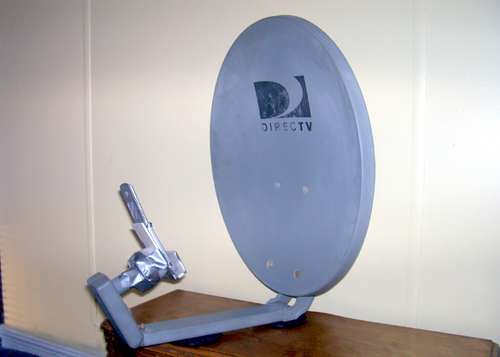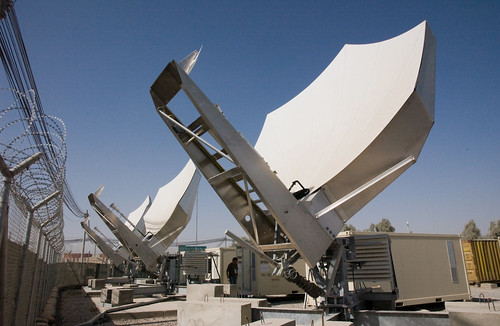This week’s satcom news, courtesy of Bill McDonald:
Globecomm Systems Inc wins multiple contracts from various Government agencies worth about $3.3m. [Satnews – 03/20/2009]
Thaicom subsidiary IPStar Co. receives licenses to bring satellite broadband services to Japan. [Satellite Today – 03/20/2009]
Stratos signs agreement to distribute ViaSat ruggedized BGAN terminals. [Satellite Today – 03/20/2009]
GeoEye starts delivering high-resolution color satellite imagery from its newest satellite to Google. [Satellite Today – 03/20/2009]
Spectacular submarine volcanic eruption in the Tonga Islands of the South Pacific captured by Moderate Resolution Imaging Spectroradiometer on NASA’s Aqua satellite March 18. [Satnews – 03/19/2009]
Satellite broadband market in Europe revived by falling price of terminals and emergence of Ka-band satellites. [Satellite Today – 03/19/2009]
EchoStar Europe targets European cable market with new range of advanced set-top boxes. [Satellite Today – 03/19/2009]
NASCAR driver Robby Gordon is sponsored by SPOT LLC, a wholly-owned subsidiary of Globalstar Inc. [msnbc – 03/19/2009]
SkyTerra Communication’s push-to-talk satellite phones purchased by Kentucky Department for Public Health under grant from U.S. Department of Health and Human Services; some to be used by emergency management agencies to keep in touch during disasters. [SatNews – 03/19/2009]
TerrSAR-X geolocation accuracy and performance exceed the product’s own standards according to report from Civil and Commercial Applications Project group within U.S. National Geospatial-Intelligence Agency. [Satellite Today – 03/19/2009]
Newtec’s Horizon HZ420 equipment selected by Movision, part of Iraqi television network Alsumaria TV, for use in the Middle East’s first ever paid-for mobile television service for mobile phones and devices. [Satnews – 03/19/2009]
Air Force’s GPS IIR-20 satellite scheduled for launch on Delta II rocket March 24 from Cape Canaveral. [Satnews – 03/18/2009]
Launch preparations underway for TerreStar-1 on another Ariane 5 while the launch of Hershel and Planck is on hold. [Satnews – 03/18/2009]
India’s future in the satellite sector holds promise of continued extraordinary progress, as highlighted at the Cable & Satellite Broadcasting Association of Asia industry conference. [Satnews – 03/18/2009]
Harris selected to provide additional Rugged Deployable Satellite Communications Terminals to U.S. Navy in a $30m follow-on order. [AP – 03/18/2009]
Launch scrubbed for Atlas V rocket carrying second Wideband Global Satellite Communications satellite. [msnbc – 03/18/2009]
WGS satellite was planned to give major communications boost to troops in Iraq and Afghanistan. [Spaceflight Now – 03/16/2009]
Arrowhead wins multimillion dollar contracts to provide commercial X-band satellite services to two U.S. government agencies. [Satellite Today – 03/18/2009]
International Launch Services and SES announce three new launch assignments under the Multi Launch Agreement that was signed in June, 2007, including NSS-14 for SES NEW SKIES and Sirius 5 for SES SIRIUS.
[Satnews – 03/18/2009]
GlobeCast launches second MCPC platform on AsiaSat 3S satellite, with European broadcaster Deutsche Welle as the first client on the new transponder. [Satnews – 03/18/2009]
GeoEye signs several agreements with international resellers to provide high-resolution satellite imagery and value-added products from GeoEye-1 Earth-imaging satellite. [Satnews – 03/18/2009]
Globecomm Systems introduces Ka-band version of its 1.2m Auto-Explorer satellite terminal designed to comply with MIL-STD-1888-164A and targeted at US Department of Defense Wideband Global SATCOM system. [BusinessWire – 03/18/2009]
Riverbed to exhibit technology at Satellite 2009 which addresses all three factors affecting satellite-based WANs – limited bandwidth, TCP behavior, and application-protocol inefficiencies.[tmcnet – 03/18/2009]
Harmonic launches universal broadcast encoder which it says is world’s first encoding and transcoding platform to support MPEG-4 and MPEG-2 in both HD and Standard Definition. Cable operators can deliver up to four HD MPEG-2 services in one QAM, and satellite operators can increase channel count per transponder. [CED Magazine – 03/18/2009]
SES ASTRA selected by European Commission to provide services to the European navigation service with tailor-made payload on Sirius 5, to be launched in second half of 2011, and related ground infrastructure. [Satnews – 03/17/2009]
Faria WatchDog Inc announces that its WatchDog 750 long-range identification and tracking ship terminal has successfully completed compliance and test requirements for operating on the Iridium satellite system. [PR Newswire – 03/17/2009]
Hughes is selected for providing broadband satellite services in Latin America by U.S. subsidiary of Ecuadorian satellite communications provider Telecomunicaciones Bantel C.A. [Trading Markets – 03/17/2009]
NDS wins IPTV contract from Russian company Comstar-United TeleSystems. [Satellite Today – 03/17/2009]
Router headed for orbit – U.S. military envisions router carrying satellite "IRIS" to launch late this summer could boost bandwidth available to military users worldwide. [DefenseNews – 03/16/2009]
United Launch Alliance wins launch contract worth about $600m to launch 4 NASA science and satellite communications missions starting in 2011. [Denver Business Journal – 03/16/2009]
Satellite 2009 conference and exhibition show projects increased attendance this year, and has added 50 new exhibiting companies showcasing newest technology for satellite-enable communications. [PR Newswire – 03/16/2009]
Governments in Eastern Europe are realizing importance of adopting satellite carriage to establish a homogeneous communications solution to advance their economic and political agendas – are spearheading revitalization of VSAT markets there. [BusinessWire – 03/16/2009]
Obama’s National Broadband Initiative – what’s in it for satellite? Fox Business News March 10 interview features Mark Dankberg, ViaSat CEO, commenting. [ViaSat News Archives – Fox Business News – 03/10/2008]








